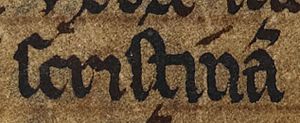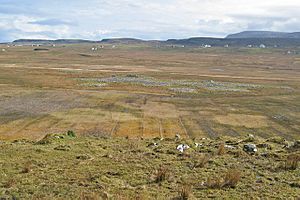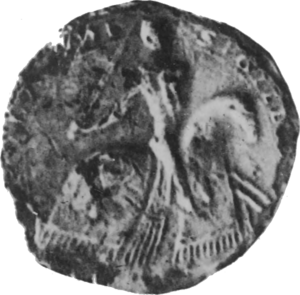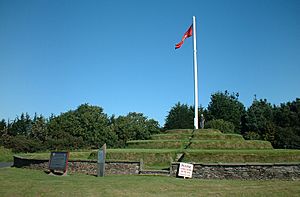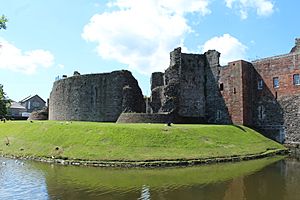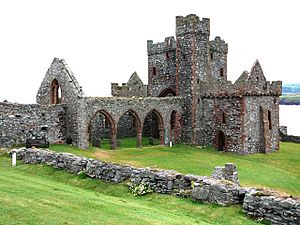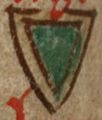Olaf the Black facts for kids
Quick facts for kids Olaf the BlackÓláfr Guðrøðarson |
|
|---|---|
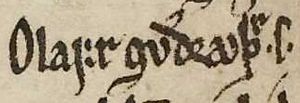
Óláfr's name as it appears on folio 102v of AM 45 fol (Codex Frisianus): "Olafr Gvðraþr.s."
|
|
| King of the Isles | |
| Reign | 1226–1237 |
| Predecessor | Rǫgnvaldr Guðrøðarson |
| Successor | Haraldr Óláfsson |
| Died | 21 May 1237 St Patrick's Isle |
| Burial | Rushen Abbey |
| Spouse |
|
| Issue | |
| House | Crovan dynasty |
| Father | Guðrøðr Óláfsson |
| Mother | Fionnghuala Nic Lochlainn |
Óláfr Guðrøðarson (died 1237), also known as Olaf the Black, was a powerful king in the 1200s. He ruled the Kingdom of the Isles, a group of islands between Scotland and Ireland. Olaf was part of the Crovan dynasty, a family that ruled these islands for a long time.
Olaf was the son of Guðrøðr Óláfsson, King of the Isles and Fionnghuala Nic Lochlainn. He had an older half-brother named Rǫgnvaldr Guðrøðarson. Even though Olaf's father wanted him to be king, the islanders chose Rǫgnvaldr because he was older and more experienced. This started a long rivalry between the two brothers for control of the kingdom.
Contents
Becoming King of the Isles
Olaf spent many years fighting for his right to rule. He faced challenges from his half-brother Rǫgnvaldr and powerful Scottish lords.
Early Life and Challenges
Olaf was born around 1173 or 1177. His parents' marriage was made official by a church leader in 1176/1177. His father, King Guðrøðr, wanted Olaf to be the next king because he was born in a "lawful marriage." However, when Guðrøðr died in 1187, Olaf was just a child. The people of the Isles chose Rǫgnvaldr, who was an adult and a strong leader.
Rǫgnvaldr ruled for nearly 40 years. During this time, Olaf tried to gain more power. He was given control of the island of Lewis and Harris, but it was a poor area.
Imprisonment and Pilgrimage
Olaf asked Rǫgnvaldr for more land, but Rǫgnvaldr had him captured. Olaf was then imprisoned by William the Lion, the King of Scotland, for almost seven years. He was released around 1214 or 1215.
After his release, Olaf went on a pilgrimage (a religious journey) to Santiago de Compostela in Spain. When he returned, he and Rǫgnvaldr seemed to make peace. Rǫgnvaldr even arranged for Olaf to marry Lauon, his own wife's sister.
Marriages and Political Moves
Olaf's marriage to Lauon didn't last. He had it canceled by the Bishop of the Isles. The reason given was that Olaf had a previous partner who was related to Lauon. However, this was likely a political move.
Olaf then married Cairistíona, the daughter of Fearchar, Earl of Ross. Fearchar was a rising Scottish leader who was loyal to the Scottish King, Alexander II, King of Scotland. Lauon's family, Clann Somhairle, was often against the Scottish Crown. By marrying Cairistíona, Olaf was making new, powerful allies in Scotland.
Conflict with Rǫgnvaldr's Son
In 1223, Olaf's new marriage angered Rǫgnvaldr's family. Rǫgnvaldr's son, Guðrøðr Dond, attacked Olaf on Lewis and Harris, forcing him to flee to his father-in-law in Ross.
Later, Olaf, with the help of Páll Bálkason, defeated Guðrøðr Dond on the island of Skye. Guðrøðr Dond was captured and severely punished, which was a common way to remove a political rival at the time. This event was a major turning point in the struggle between Olaf and Rǫgnvaldr.
Dividing the Kingdom
In 1224, Olaf gathered a fleet of ships and confronted Rǫgnvaldr on the Isle of Man. They agreed to split the kingdom: Rǫgnvaldr would keep Mann and the title of king, while Olaf would rule parts of the Hebrides.
Rǫgnvaldr then sought help from Alan fitz Roland, Lord of Galloway, a very powerful Scottish lord. Alan and Rǫgnvaldr were allies and campaigned against Olaf. However, the people of Mann were not keen to fight Olaf.
In 1226, Rǫgnvaldr married his daughter to Alan's son, Thomas. This alliance made the islanders angry because they feared Alan's family would take over the kingdom. As a result, they removed Rǫgnvaldr from power and made Olaf king.
Rǫgnvaldr's Final Battle
In 1228, while Olaf was away, Rǫgnvaldr, Alan, and Alan's brother attacked Mann, causing great destruction. Olaf asked the English King, Henry III, King of England, for help.
In early 1229, Rǫgnvaldr launched a surprise attack on Olaf's ships at St Patrick's Isle. He then gained support in the southern part of Mann. Olaf gathered his forces in the north, and the island was divided.
On February 14, 1229, Olaf's forces attacked Rǫgnvaldr at Tynwald Hill, a traditional assembly site. Rǫgnvaldr's troops were defeated, and he was killed in battle. This victory solidified Olaf's position as the sole King of the Isles.
Norwegian Involvement
Even after Rǫgnvaldr's death, Alan and other powerful families continued to challenge Olaf. This led to the King of Norway getting involved.
Norway Sends a Fleet
In 1230, Olaf was forced out of his kingdom by Alan and his allies. News of the fighting reached Hákon Hákonarson, King of Norway. Hákon decided to send a large fleet to the Isles to restore order. He appointed Óspakr, a member of Clann Somhairle who had served in Norway, as the new King of the Isles and leader of the fleet.
Olaf traveled to Norway and reported Alan's actions to King Hákon. Óspakr's fleet, with Olaf and Páll Bálkason, sailed to the Isles. They attacked and captured Rothesay Castle on the Isle of Bute.
However, Óspakr was injured during the attack and later died. Olaf then took command of the Norwegian fleet.
Sharing Power and Full Control
Olaf led the fleet to the Copeland Islands for safety and supplies. They then sailed to Mann. Olaf and Guðrøðr Dond (Rǫgnvaldr's son, who had been punished by Olaf earlier) divided the kingdom. Olaf controlled Mann, and Guðrøðr Dond controlled the other islands.
This shared rule didn't last long. When the Norwegian fleet left in the spring of 1231, Guðrøðr Dond was killed. After his death, Olaf finally gained full control of the entire Kingdom of the Isles. He ruled peacefully until his own death in 1237.
The Norwegians saw this as a success, as it brought stability to the region. The Scots likely also welcomed it, as Olaf had ties to Scottish leaders.
Later Years and Legacy
After 1231, Alan fitz Roland stopped his attacks on Olaf. It seems the Scottish King, Alexander II, wanted a more peaceful relationship with the rulers of the Isles.
Olaf was involved in trade and granted rights to churches on Mann, showing his support for religious institutions. He also visited King Henry III of England in 1235, promising to protect English and Irish coasts in exchange for an annual payment and supplies.
Olaf died on May 21, 1237, on St Patrick's Isle. He was buried at Rushen Abbey, which became a burial place for his family.
Olaf was succeeded by his son, Haraldr Óláfsson. Two more of Olaf's sons, Rǫgnvaldr and Magnús, also ruled the kingdom later. Magnús was the last king of the Crovan dynasty. The conflicts within the family continued for another generation, showing how difficult it was to maintain peace and control in the Isles.
Images for kids
-
Óláfr's name as appears on folio 163r of AM 47 fol (Eirspennill): "Olafr suárti". The Old Norse epithet svarti refers to the colour "black".
-
A queen gaming piece of the Lewis chessmen, thought to be from Norway.
-
The name of Páll Bálkason.
-
The title of Óláfr's father, Guðrøðr Óláfsson, as it appears on folio 40r British Library Cotton Julius A VII: "rex insularum" ("King of the Isles").
-
Castle Rushen on the Isle of Man.
-
Coat of arms of Henry III, King of England.
-
St Patrick's Isle, a Manx power center for Óláfr.
-
The name and title of Óspakr as it appears on folio of 174r of GKS 1005 fol: "Vspakr konungr" (Flateyarbók).
-
Detail from Maughold IV, a Manx runestone displaying a contemporary sailing vessel.
-
Mannequin of Óláfr's sister, Affrica, at Carrickfergus Castle.
-
Coat of arms of Hákon Hákonarson.




